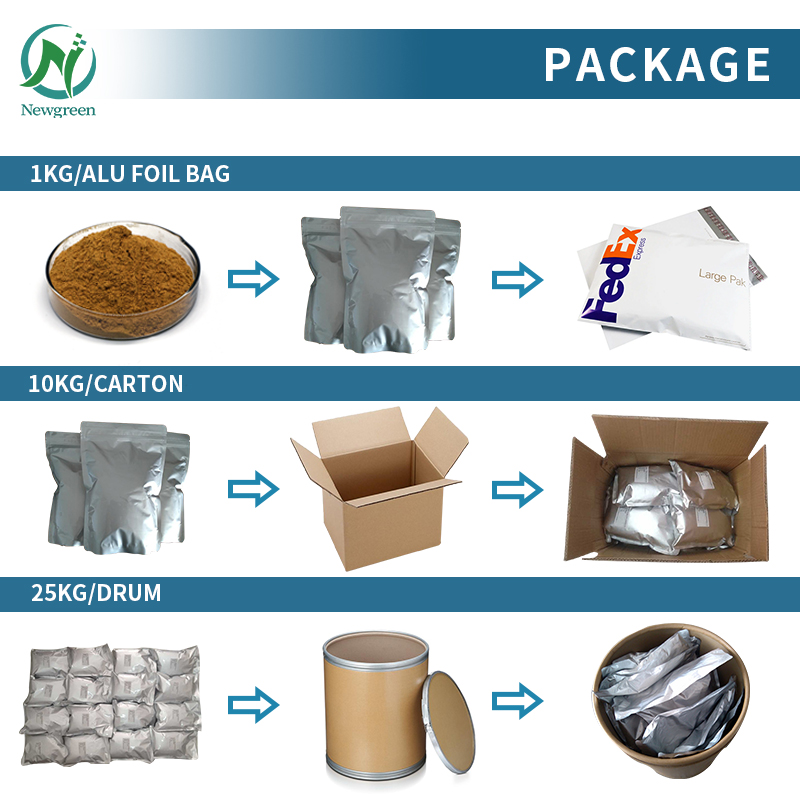Newgreen Supply Luliconazole Powder With Low Price Bulk

Product Description
Luliconazole is a broad-spectrum antifungal drug, mainly used to treat fungal infections of the skin. It belongs to the imidazole antifungal drug class and has the effect of inhibiting fungal growth. Luliconazole inhibits the growth and reproduction of fungi by interfering with the synthesis of fungal cell membranes.
Indications
Luliconazole is mainly used to treat the following fungal skin infections:
- Tinea pedis (athlete's foot)
- Tinea cruris
- Tinea corporis
- Other skin infections caused by fungi
Dosage Form
Luliconazole is usually available as a topical cream that patients apply directly to the infected area of skin.
Usage
When used, it is generally recommended to apply an appropriate amount of ointment on clean and dry skin, usually once a day for several weeks. The specific usage time should follow the doctor's advice.
Notes
When using luliconazole, patients should avoid contact with eyes and mucous membranes and tell their doctor if they have a history of allergies or other health problems before use.
In general, luliconazole is an effective topical antifungal drug suitable for the treatment of a variety of fungal skin infections. It should be used under the guidance of a doctor to ensure safety and effectiveness.
COA
| Items | Specifications | Results | |
| Appearance&color | White or almost white crystalline powder
|
Complies | |
| Assay( Luliconazole ) | 96.0~102.0% | 99.8% | |
|
Related Substances |
Impurity H | ≤ 0.5% | N.D |
| Impurity L | ≤ 0.5% | 0.02% | |
| Impurity M | ≤ 0.5% | 0.02% | |
| Impurity N | ≤ 0.5% | N.D | |
| Sum of peak areas of impurity D and impurity J | ≤ 0.5% | N.D | |
| Impurity G | ≤ 0.2% | N.D | |
| Other single impurity | The peak area of other single impurity shall not be greater than 0.1% of the main peak area of the reference solution | 0.03% | |
| Total Impurities % | ≤ 2.0% | 0.50% | |
|
Residual Solvents |
Methanol | ≤ 0.3% | 0.0022% |
| Ethanol | ≤ 0.5% | 0.0094% | |
| Acetone | ≤ 0.5% | 0.1113% | |
| Dichloromethane | ≤ 0.06% | 0.0005% | |
| Benzene | ≤ 0.0002% | N.D | |
| Methylbenzene | ≤ 0.089% | N.D | |
| Triethylamine | ≤ 0.032% | 0.0002% | |
| Conclusion
|
Qualified | ||
Function
Luliconazole is a broad-spectrum antifungal drug mainly used to treat skin infections caused by fungi. Its main functions include:
1. Antifungal effect: Luliconazole can effectively inhibit the growth of a variety of fungi, including dermatophytes (such as tinea tricolor, tinea pedis, tinea cruris, etc.), by interfering with the synthesis of fungal cell membranes.
2. Treatment of fungal skin infections: It is widely used to treat various fungal skin infections, especially common skin diseases such as tinea pedis, tinea corporis and tinea cruris.
3. Topical Application: Luliconazole is usually used in the form of a topical cream that is applied directly to the infected skin area for the convenience of the patient.
4. Quick Effect: Many clinical studies have shown that luliconazole has a rapid effect in treating fungal skin infections, and improvements can usually be seen within a short period of time.
5. Good tolerability: Most patients tolerate luliconazole well, with relatively few side effects, mainly local irritation.
In short, the main function of luliconazole is to be used as an effective antifungal drug for the treatment of various skin fungal infections, helping patients relieve symptoms and promote skin healing. When using it, you should follow the doctor's instructions to ensure safety and effectiveness.
Application
The application of Luliconazole is mainly focused on the treatment of skin infections caused by fungi. The following are its main application areas:
1. Skin fungal infections: Luliconazole is widely used to treat various skin fungal infections, including:
- Tinker's foot: A skin disease of the feet caused by fungal infection, often accompanied by itching, peeling and redness.
- Tingrea corporis: A fungal infection affecting other parts of the body, usually presenting as a ring-shaped red rash.
- Jock itch: A fungal infection that affects the inner thighs and buttocks, often found in moist environments.
2. Topical preparations: Luliconazole is usually provided in the form of a topical cream that patients can conveniently apply to the infected skin area. When used, it is usually recommended to apply it on clean and dry skin, usually once a day for several weeks.
3. Prophylactic Use: In certain circumstances, luliconazole may also be used to prevent fungal infections, especially in high-risk groups such as athletes or people who work in humid environments.
4. Clinical Research: Luliconazole has shown good efficacy and safety in clinical trials, and many studies have demonstrated its effectiveness and tolerability in the treatment of fungal skin infections.
5. Combination with other treatments: In certain complicated cases, luliconazole may be used in combination with other antifungal drugs to enhance the therapeutic effect.
In summary, the main application of luliconazole is as an effective topical antifungal drug specifically used to treat and prevent various skin fungal infections. When using it, you should follow the doctor's guidance to ensure the best effect and safety.
Package & Delivery



















